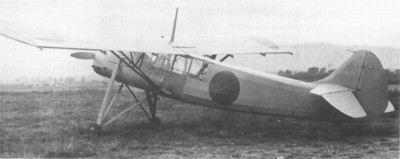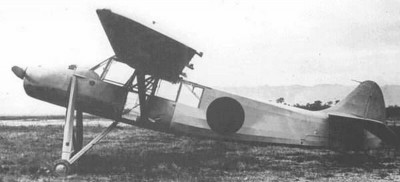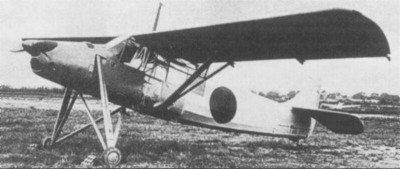| Název: Name: | Kobeseiko Te-Go | Kobeseiko Te-Gō |
| Originální název: Original Name: | テ号観測機 | |
| Kategorie: Category: | průzkumný/pozorovací letoun | reconnaissance/scout aeroplane |
| Výrobce: Producer: | DD.MM.1942-DD.MM.1942 Kobe Steel Ltd., Kobe | |
| Období výroby: Production Period: | DD.MM.1942-DD.MM.1942 | |
| Vyrobeno kusů: Number of Produced: | 1 (2 ?) | |
| První vzlet: Maiden Flight: | DD.MM.1942 | |
| Osádka: Crew: | 2 | |
| Základní charakteristika: Basic Characteristics: | ||
| Vzlet a přistání: Take-off and Landing: | CTOL - konvenční vzlet a přistání | CTOL - conventional take-off and landing |
| Uspořádání křídla: Arrangement of Wing: | jednoplošník | monoplane |
| Uspořádání letounu: Aircraft Concept: | klasické | conventional |
| Podvozek: Undercarriage: | pevný | fixed |
| Přistávací zařízení: Landing Gear: | kola | wheels |
| Technické údaje: Technical Data: | ||
| Hmotnost prázdného letounu: Empty Weight: | 780 kg | 1720 lb |
| Vzletová hmotnost: Take-off Weight: | 1130 kg | 2491 lb |
| Maximální vzletová hmotnost: Maximum Take-off Weight: | ? kg | ? lb |
| Rozpětí: Wingspan: | 13,000 m | 42ft 7,81in |
| Délka: Length: | 9,500 m | 31ft 2,01in |
| Výška: Height: | 3,500 m | 11ft 5,8in |
| Plocha křídla: Wing Area: | 20,00 m2 | 215.28 ft2 |
| Plošné zatížení: Wing Loading: | 56,50 kg/m2 | 11.57 lb/ft2 |
| Pohon: Propulsion: | ||
| Kategorie: Category: | pístový | piston |
| Počet motorů: Number of Engines: | 1 | |
| Typ: Type: | Argus As 10c vzduchem chlazený invertní osmiválec o výkonu 177 kW (240 k) Vrtule dvoulistá dřevěná s pevným úhlem náběhu vrtulových listů o průměru 2 750 mm. | Argus As 10c air-cooled inverted V8 rated 237 hp, driving a two-blade fixed-pitch wooden propeller of 9ft 0,26in diameter. |
| Objem palivových nádrží: Fuel Tank Capacity: | ? | ? |
| Výkony: Performance: | ||
| Maximální rychlost: Maximum Speed: | 180 km/h v m | mph in ft |
| Cestovní rychlost: Cruise Speed: | 155 km/h v m | mph in ft |
| Rychlost stoupání: Climb Rate: | 4,7 m/s | 925.2 ft/min |
| Čas výstupu na výšku: Time to Climb to: | ? min do ? m | ? min to ? ft |
| Operační dostup: Service Ceiling: | 4500 m | 14764 ft |
| Dolet: Range: | 375 km | 233 mi |
| Maximální dolet: Maximum Range: | ? km | ? mi |
| Výzbroj: Armament: | 1x pohyblivý kulomet Type 89 ráže 7,7 mm | One flexible rear-firing 0.303 inch Type 89 machine-gun. |
| Uživatelské státy: User States: | - | - |
| Poznámka: Note: | テ号観測機 / Te-go Kansoku-ki / pozorovací letoun Te-Go Te-Go = Pevné křídlo (jap.) znamená letoun s pevným křídlem, současně se zkoušel vírník Ka-Go později Kayaba Ka-1 Ka-Go znamenalo letoun s pohyblivým křídlem. | テ号観測機 / Te-gō Kansoku-ki / experimental artillery spotter and liaison aircraft |
| Zdroje: Sources: | http://www.aviastar.org/air/japan/kobe_tego.php http://www.airwar.ru/enc/spyww2/tego.html archiv autora | |
Kobeseiko Te-Go
Kobeseiko Te-Gō
テ号観測機
Kobeseiko Te-Go
テ号観測機 / Te-go Kansoku-ki / Te-Go observation aircraft
History:
Fieseler Fi 156 Storch was a legend both for its properties and for its appearance, news of such an aircraft quickly reached Japan. The Japanese Air Force was very interested in such an aircraft with a short takeoff and landing. Through its military attaché in Berlin, Storch sought to purchase or arrange for its licensed production. Unfortunately, in the end, not a single variant was realized and so in Japan a completely own design was created - an observation aircraft Kokusai Ki-76.
The Japanese aircraft was only inspired by Storch and there is no question of a copy. The Army Air Force used this aircraft to perform observation and liaison tasks, as well as for anti-submarine patrols. It was powered by a more powerful Hitachi Ha-42 star engine and the machine was also more powerful than the German ideological model. Finally, on April 28, 1941, Storch arrived in Japan in a disassembled state, less than a month before the take-off of the Ki-76 prototype. The Japanese pilots, in June of the same year after the tests, evaluated their own design better than the German one. According to Japanese tests, Storch had only a shorter landing.
Storch eventually got to Japan, but the Japanese no longer showed interest in it, but bought the rights to license the production of engines Argus As 10C, so they got the engine that powered Storcha. Rikugun Koku Hombu (Army Air Force Command) wanted to have in reserve another type of observation aircraft, which could be smaller and simpler thanks to a lighter engine. The development of this aircraft was commissioned in 1941 by the Imperial University in Osaka. The aircraft did not receive any military designation by the system Kitai. The work on the project and later also the construction work was led by prof. Tetsuo Miki of the Aviation Department.
This construction was also influenced by the German Storch, a strut topplane was created on a high sprung landing gear. The construction of the aircraft was mixed, the fuselage was made of tubes and wood, the whole was covered with canvas, the whole except the engine covers and panels around the cabin, here was used dural. The wing had an all-wood construction, which was covered with canvas or plywood. Unlike the Ki-76 or Storch, the leading edge of the wing formed a retractable slot (the Ki-76 and Storch had a fixed slot), on the trailing edge of the wing were large flaps of a similar design as the Fowler flaps. The two-member crew had an easier view down below the aircraft facilitated by side windows. The defense was to provide one machine gun Type 89 with drum magazines, which could be extended only partially after moving the rear of the cabin. Thanks to the used engine Argus As 10c with Te-Go aircraft, such was the designation of the aircraft, very similar to his German model.
The production did not take place, because during one of the demonstration flights, it took off in 1942, the machine crashed, the left landing gear leg broke and then the left wing collapsed. This aircraft reportedly had even better features than the Ki-76 Stella. The prototype was made by a small factory Kobeseiko (Kobe Seikoyo) Kabushiki Kaisha. Some sources state that two prototypes were built, the second prototype was to be destroyed in an American air raid shortly after its completion.
Sources used for the full post:
René J. Francillon Ph.D., Japanese Aircraft of the Pacific War, Naval Institute Press, 1987, Reprinted 1990, ISBN: 0-87021-313-X
Tadeusz Januszewski and Kryzysztof Zalewski, Japońskie samoloty marynarski 1912-1945, part 1., Lampart, year 2000, ISBN: 83-86776-50-1
Mgr. Ivan Víšek, Te-Go or "Stork" from the Pacific, Revi No. 33, August 2000, pp. 36-37, ISSN 1211-0744
https://www.aviastar.org/air/japan/kobe_tego.php
uk.geocities.com
ja.wikipedia.org
https://www.airwar.ru/enc/spyww2/tego.html
author's archive
テ号観測機 / Te-go Kansoku-ki / Te-Go observation aircraft
History:
Fieseler Fi 156 Storch was a legend both for its properties and for its appearance, news of such an aircraft quickly reached Japan. The Japanese Air Force was very interested in such an aircraft with a short takeoff and landing. Through its military attaché in Berlin, Storch sought to purchase or arrange for its licensed production. Unfortunately, in the end, not a single variant was realized and so in Japan a completely own design was created - an observation aircraft Kokusai Ki-76.
The Japanese aircraft was only inspired by Storch and there is no question of a copy. The Army Air Force used this aircraft to perform observation and liaison tasks, as well as for anti-submarine patrols. It was powered by a more powerful Hitachi Ha-42 star engine and the machine was also more powerful than the German ideological model. Finally, on April 28, 1941, Storch arrived in Japan in a disassembled state, less than a month before the take-off of the Ki-76 prototype. The Japanese pilots, in June of the same year after the tests, evaluated their own design better than the German one. According to Japanese tests, Storch had only a shorter landing.
Storch eventually got to Japan, but the Japanese no longer showed interest in it, but bought the rights to license the production of engines Argus As 10C, so they got the engine that powered Storcha. Rikugun Koku Hombu (Army Air Force Command) wanted to have in reserve another type of observation aircraft, which could be smaller and simpler thanks to a lighter engine. The development of this aircraft was commissioned in 1941 by the Imperial University in Osaka. The aircraft did not receive any military designation by the system Kitai. The work on the project and later also the construction work was led by prof. Tetsuo Miki of the Aviation Department.
This construction was also influenced by the German Storch, a strut topplane was created on a high sprung landing gear. The construction of the aircraft was mixed, the fuselage was made of tubes and wood, the whole was covered with canvas, the whole except the engine covers and panels around the cabin, here was used dural. The wing had an all-wood construction, which was covered with canvas or plywood. Unlike the Ki-76 or Storch, the leading edge of the wing formed a retractable slot (the Ki-76 and Storch had a fixed slot), on the trailing edge of the wing were large flaps of a similar design as the Fowler flaps. The two-member crew had an easier view down below the aircraft facilitated by side windows. The defense was to provide one machine gun Type 89 with drum magazines, which could be extended only partially after moving the rear of the cabin. Thanks to the used engine Argus As 10c with Te-Go aircraft, such was the designation of the aircraft, very similar to his German model.
The production did not take place, because during one of the demonstration flights, it took off in 1942, the machine crashed, the left landing gear leg broke and then the left wing collapsed. This aircraft reportedly had even better features than the Ki-76 Stella. The prototype was made by a small factory Kobeseiko (Kobe Seikoyo) Kabushiki Kaisha. Some sources state that two prototypes were built, the second prototype was to be destroyed in an American air raid shortly after its completion.
Sources used for the full post:
René J. Francillon Ph.D., Japanese Aircraft of the Pacific War, Naval Institute Press, 1987, Reprinted 1990, ISBN: 0-87021-313-X
Tadeusz Januszewski and Kryzysztof Zalewski, Japońskie samoloty marynarski 1912-1945, part 1., Lampart, year 2000, ISBN: 83-86776-50-1
Mgr. Ivan Víšek, Te-Go or "Stork" from the Pacific, Revi No. 33, August 2000, pp. 36-37, ISSN 1211-0744
https://www.aviastar.org/air/japan/kobe_tego.php
uk.geocities.com
ja.wikipedia.org
https://www.airwar.ru/enc/spyww2/tego.html
author's archive
Reklama
This post has not been translated to English yet. Please use the TRANSLATE button above to see machine translation of this post.
| Period | - |
| Producer | - |
| Type | - |
| Camouflage | - |
| Country | - |
| Pilot | - |
| Production No. | - |
| Serial No. / Evidence No. | - |
| Tactical Marking / Imatriculation | - |
| Name | - |
| Unit | - |
| Base | - |
| Date (DD.MM.RRRR) | - |
| Author | - |
| Print size / 300 DPI | - |
| Published with authors permit | - |
| Author Website | - |
| Period | - |
| Producer | - |
| Type | - |
| Camouflage | - |
| Country | - |
| Pilot | - |
| Production No. | - |
| Serial No. / Evidence No. | - |
| Tactical Marking / Imatriculation | - |
| Name | - |
| Unit | - |
| Base | - |
| Date (DD.MM.RRRR) | - |
| Author | - |
| Print size / 300 DPI | - |
| Published with authors permit | - |
| Author Website | - |
| Period | - |
| Producer | - |
| Type | - |
| Camouflage | - |
| Country | - |
| Pilot | - |
| Production No. | - |
| Serial No. / Evidence No. | - |
| Tactical Marking / Imatriculation | - |
| Name | - |
| Unit | - |
| Base | - |
| Date (DD.MM.RRRR) | - |
| Author | - |
| Print size / 300 DPI | - |
| Published with authors permit | - |
| Author Website | - |
Join us
We believe that there are people with different interests and experiences who could contribute their knowledge and ideas. If you love military history and have experience in historical research, writing articles, editing text, moderating, creating images, graphics or videos, or simply have a desire to contribute to our unique system, you can join us and help us create content that will be interesting and beneficial to other readers.
Find out more

